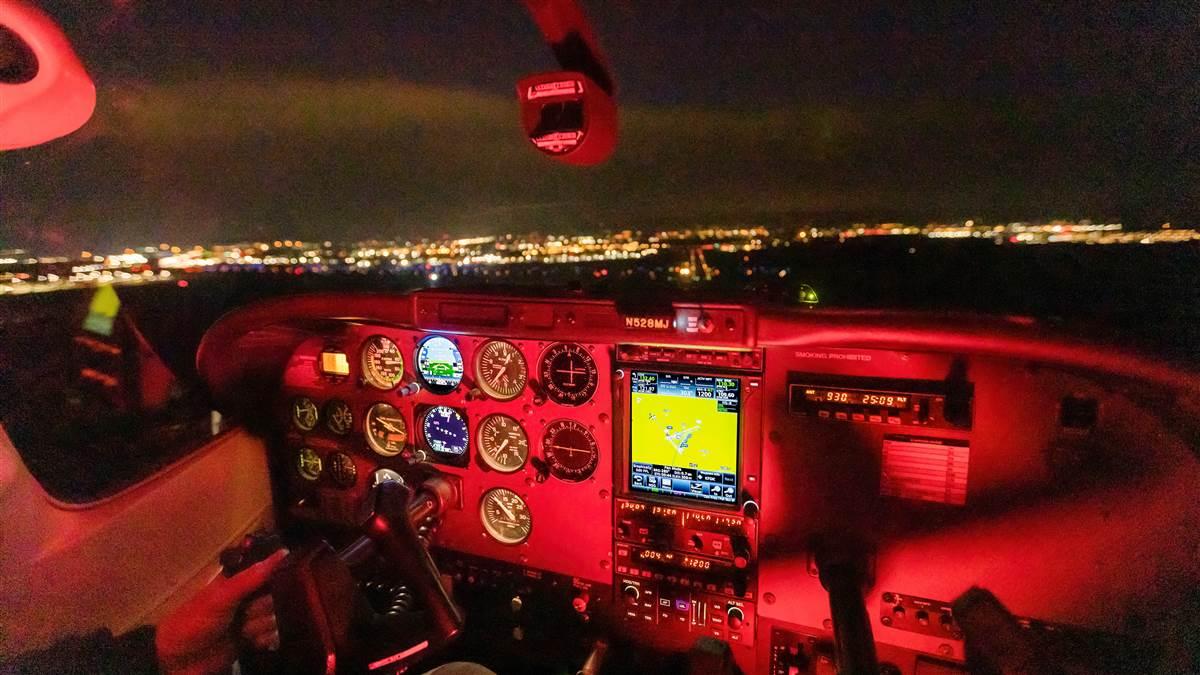Don’t be afraid of the dark
Tips for night flights and landings

Before the flight
Prepping for a night flight begins well before engine start. Just like before any lesson, you should be well rested. Because of our natural circadian rhythms, a dark sky will likely make you feel more tired and less focused than when you are flying a daytime lesson. While potentially inconvenient, it is helpful to plan your day around the night flight. For flight instructors, this might mean taking the morning off from instructing and scheduling lessons with other students only for the afternoon and evening. For students, this might mean scheduling night flights on a weekend, so you have the day to rest instead of trying to squeeze in a flight after a full day of work.
Other than a potential increase in tiredness, your vision will also be affected by night. At night, our vision dramatically decreases, but we can adapt slightly. It takes about 30 to 45 minutes for our eyes to adjust to darkness. During that time, our eyes create a light-sensitive receptor protein called rhodopsin. This protein is also called “visual purple” and it helps us to see better in the dark. Because it is light-sensitive, it dissipates as soon as you see bright light. That’s why as you get ready for a night flight, you must be very careful to protect your eyes from bright light, like flashlights, phone screens, and even your aircraft’s strobes. Rhodopsin is less sensitive to red light, which is why we use red lights during night flights to maintain our night vision and illuminate instruments, charts, and more when necessary. Make sure you know how to adjust the lighting on your instruments or the brightness of your glass cockpit display before the flight.
And while you’re used to looking outside to fly under visual flight rules, even on a VFR night flight, you’ll need to rely on your instruments. In fact, the United States is one of the few places in the world where you can fly at night without an instrument rating. Night flying is similar to instrument flying even on a clear night—the horizon and terrain may be difficult or impossible to see. Possible obstructions like debris or animals on or next to runways or taxiways may also be hard to see, so stick to the centerline.
To avoid seriously needing those instruments, it is best to wait for near perfect weather for your first night flight. It’ll be hard or impossible to see any potential clouds and avoid flying VFR into instrument meteorological conditions, and good weather will reduce risk.

Sunset to sunrise: What we generally think of as night, and the time when you are required to have position and anticollision lights on (left).
Evening civil twilight to morning civil twilight: The FAA’s standard definition of night, and the definition used for logging aeronautical experience towards a certificate (center).
One hour after sunset to one hour before sunrise: The definition of night used for night currency and carrying passengers (right).
The flight
Now let’s get to the airplane. As you’ve figured out by now, every part of the flight will be at least a little different because of the darkness. You’ll need a flashlight for preflight, and a familiar taxi route might suddenly seem confusing and disorienting. One key to success? Take it slow. Don’t rush through anything, and check and verify your taxi route.
Turning on the taxiway and runway lights at the airport may be up to you. Usually, this is five clicks on the common traffic advisory frequency, but it may be seven if high intensity lights are an option at your airport. Other than great landings, turning on the lights is one of the most fun things in aviation.
At a towered field, the air traffic controller will take care of the lights, but they might forget (especially around dawn or dusk) so feel free to remind them if that’s the case.
Illusions
We already know that our eyes won’t work as well at night, and that we’re more likely to get confused/be tired/need to rely on our instruments, but there’s one more big factor we need to prepare for: visual illusions.
Darkness affects our depth perception, and this adds complexity to night landings. It’ll be harder than normal to judge distance and altitude. In a remote area where the runway lights are the only (or some of the few) lights you can see, this can lead to a black hole approach, where you might perceive yourself as higher than you actually are. On the other hand, very bright lights can lead you to think you are lower than you are—the brightness indicating to your eyes that you are closer to the light than you are. Any rain or haze will also distort your perception of distance—another reason to wait for a good weather night. One way to keep yourself on glideslope and mitigate these illusions is to trust the PAPI or VASI approach lights, tune in the ILS or GPS instrument approach as backup guidance, and be sure to set your altimeter before takeoff.
Even though you’ll be on a VFR flight, there’s an increased chance of spatial disorientation as well. Anything that obscures the horizon—clouds, haze, other weather, the darkness of a body of water—will make it harder to stay straight and level by just looking outside, and you will need to use your instruments to stay safe far more than on a normal clear-and-a-million day flight. Rows of lights can give the impression of a horizon as well. If you keep a close eye on your instruments, this can be avoided.
Autokinesis is another possible illusion, although this is less likely in the pattern. If you keep your eyes focused on one bright spot for too long, it will appear to move. This could give you the impression of an aircraft that you must avoid, leading to unneeded “corrections” and creating general disorientation. Avoid focusing your eyes in one spot for too long to prevent this illusion.
In the pattern
So, with all these stressful factors, how do you succeed at night landings? Take it slow, prepare, and expect it to be a little different. Fly deliberately, smoothly, and intentionally. It’s just a landing, after all—the airplane doesn’t know how bright it is outside, and it’ll act just like it does during the day, as long as you do too.
You’ll want as few distractions as possible. Put your phone and smartwatch in airplane mode to keep it from lighting up and distracting you (and affecting your night vision) during the flight.
Use your heading bug/heading indicator to help you fly a square pattern, since the visual references you use during the day might not be distinguishable at night. This will also help make sure you’re lined up for the correct runway once you’re on final—believe it or not, it is easy to get lined up for a crossing runway, or even a well-lit road.
Once you’re on final approach, verify you’re lined up for the correct runway, and double-check your altitude as you descend to make sure you are neither too high nor too low. Once you get into the flare, look down the runway as much as you can—don’t fixate on the small area illuminated by your landing light. Flare gently and pay extra attention to your airspeed and attitude right before touchdown. There’s a tendency to freeze at the controls when you aren’t sure what’s happening, or over-flare to get on the ground more quickly. But take it slow, trust your instructor to keep you safe, and do what you already know how to do—land the airplane.
You need three full-stop landings for night currency, and the rest to reach your pre-checkride aeronautical experience can be touch and goes, but in the beginning, plan on doing full-stop taxi-backs for every landing. It’ll cost more, sure, but it’ll also decrease risk and help keep your situational awareness high. The moon can be surprisingly bright, so fly during a full moon if you want a little extra light. If there is any question about the weather, call it off.
Also, maybe it should go without saying, but you should actually know how to land before you do night landings. You’ll also want a good command of trim, which will help reduce your workload in the pattern and make your experience more pleasant.
After all those factors, struggles and risks, you’ll be rewarded with one of the most spectacular flight conditions available to us—night! You’ll get to see city lights from above, check out fireworks, and see the stars like never before. Night flying feels otherworldly. Beyond the reward of witnessing the world as few ever do, that extra prep and challenge of flying without sunlight will make you a better pilot.
It might seem overwhelming at first, but after the first few landings, and with the help of your instructor, you’ll get the hang of it.





